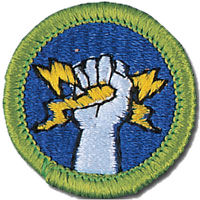Electricity


Resources
- Electricity Merit Badge Pamphlet
- Electricity Merit Badge Class Preparation Page
- Electricity Merit Badge Workbook
- Scoutmaster Bucky's Merit Badge Advancement Quick Reference
- Scoutmaster Bucky's Acknowledgement Form
Electricity Requirements
Current Scouts BSA requirements
as of December 6, 2025
as of December 6, 2025
1.
Demonstrate that you know how to respond to electrical emergencies by doing
the following:
a.
Explain how to turn off power for a particular circuit and the whole
house in the event of an emergency.
b.
Demonstrate how to rescue a person touching a live wire in the home.
c.
Describe how to safely get out of a car in an accident if you suspect a
utility wire is on the car.
d.
Show how to render first aid to a person who is unconscious from an
apparent electrical shock.
e.
Show how to treat an electrical burn.
f.
Explain what to do in the event of an electrical fire.
g.
Explain what to do if caught out in the open during an electrical
storm.
2.
Complete an electrical home safety inspection of your home, using the
checklist found in the Electricity merit badge pamphlet or one
approved by your counselor. Discuss what you find with your counselor.
3.
Make a simple electromagnet and use it to show magnetic attraction and
repulsion.
4.
Do the following:
a.
Explain the difference between direct current and alternating current,
the advantages and disadvantages of each, and give a practical example
of the use of each type.
b.
Explain three ways that electricity is produced.
5.
Make a simple drawing to show how a battery and an electric bell work.
Describe the purpose of each of the components.
6.
Do the following:
a.
Define what overloading an electric circuit means. Tell what you have
done to make sure your home circuits are not overloaded.
b.
Determine if there is an overload on a branch circuit by either getting
the current draw from all the equipment plugged into the circuit or use
the power equation to calculate the current draws.
c.
Explain why a fuse blows and a circuit breaker trips.
d.
Tell how to find a blown fuse and a tripped circuit breaker in your
home. Show how to safely reset the circuit breaker.
7.
Make a floor plan wiring diagram of the lights, switches, and outlets for a
room in your home. Show which fuse or circuit breaker protects each one.
8.
Do the following:
a.
Read a meter associated with an electric bill. Determine the total
power used since the bill, and the cost of that power.
b.
Explain other charges on the bill that were taxes or fees.
c.
Discuss with your counselor five ways your family can conserve
energy.
9.
Explain the following:
a.
Electrical terms - Current, energy, power, resistance, and voltage
b.
Units of measure - Ampere (amps), ohms, volts, watts, and watt-hours
c.
Electrical conditions - Generating source with example, ground, open
circuit, overvoltage, potential difference, and short circuit
d.
Equipment and their use - circuit, conductor, Ground Fault Circuit
Interrupter (GFCI), insulator, inverter, rectifier, rheostat,
substation, surge protection, solar panel, transformer, transmission
and distribution systems, and wind turbine.
10.
Do TWO of the following:
a.
Connect a buzzer, bell, or light with a battery. Have a key or switch
in the line.
b.
Make and run a simple electric motor (from a kit is acceptable, if
approved by your counselor ahead of time).
c.
Build a simple rheostat. Show that it works.
d.
Build a single-pole, double-throw switch. Show that it works.
e.
Explain how 3-way switch wiring works in a lighting circuit.
f.
Connect two lights together in a series circuit along with a battery
and a switch. Then connect the same circuit in parallel. Discuss the
differences in the two circuits.
11.
Identify three career opportunities that would use skills and knowledge in
electricity. Pick one and research the training, education, certification
requirements, experience, and expenses associated with entering the field.
Research the prospects for employment, starting salary, advancement
opportunities and career goals associated with this career. Discuss what
you learned with your counselor and whether you might be interested in this
career.